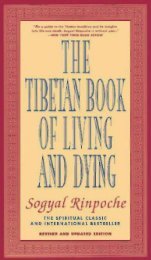Mandukya_Upanishad
Mandukya_Upanishad
Mandukya_Upanishad
You also want an ePaper? Increase the reach of your titles
YUMPU automatically turns print PDFs into web optimized ePapers that Google loves.
THE INDIVIDUAL AND THE ABSOLUTEThe first mantra of the Māndūkya <strong>Upanishad</strong> describesthe nature of Omkāra and its connotation in relation to thewhole universe. Now, it also denotes some object, as waspointed out earlier. It is a Universal Name which refers to aUniversal Form in such a manner that the Name and theForm coalesce to constitute one Being. As the Name isUniversal and the Form also is Universal, they havenaturally to blend into a single existence, because we cannothave two Universals standing apart from each other. Thereis, therefore, the Universal Name coalescing with theUniversal Form; nāmā and rūpa become one in thisexperience-whole. That experience is neither nāmā norrūpa, by itself. It is both, and yet neither. God is not merelya form denoted by a name, nor is He an object that can bedescribed by any person. As all persons are included withinthe body of God, there is no naming God by any otherentity outside it. Hence, in a sense, we may say that God isnameless. Who can call Him by a name? Where is thatperson who can call Him by a name! As there is, therefore,essentially, no name, in the ordinary sense of the term, thatcan designate God, He cannot also be regarded as a rūpa ora form which corresponds to a nāmā or a name. There is anindescribable something which is designated ultimately byOmkāra or Praṇava, and, being indescribable, it isvisualised by a name that conveys the best of possiblemeanings. Though it may itself have no name, and itcannot also be said to have any particular form, we, as jīvas,individuals here on earth, cannot envisage it in thattranscendent nature. We have to conceive it in our minds



